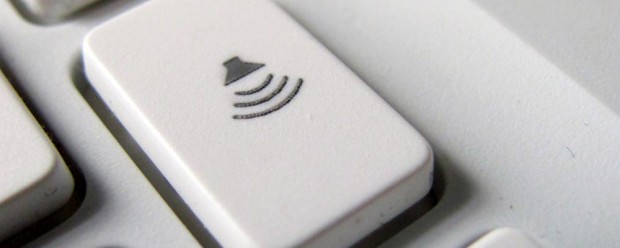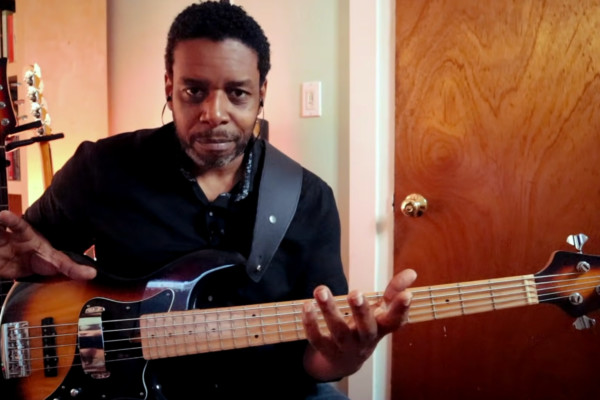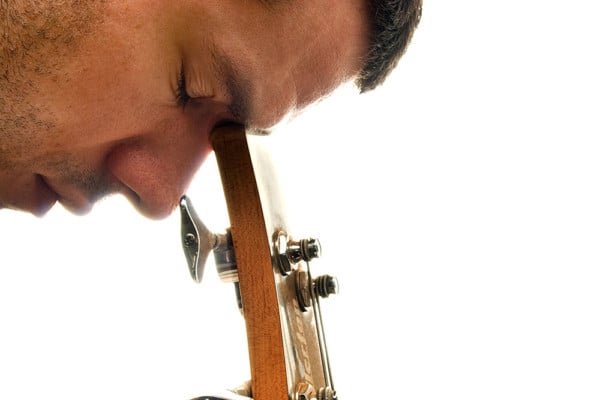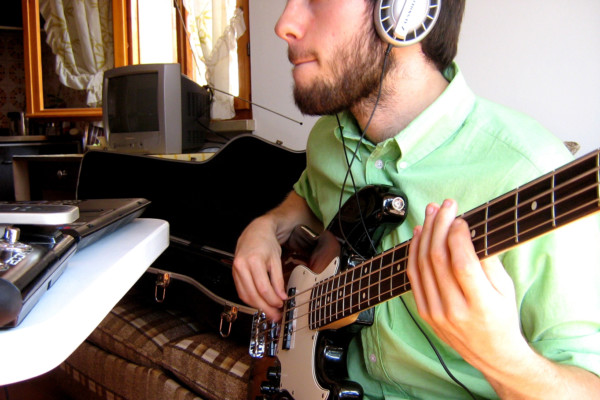No Bass Amp? A Guide to Hearing Yourself Practice

Q: My amp and most of my gear got confiscated when I got to college because they said it was a fire hazard. What do you recommend for some amp-less ways for me to get my sound amplified? I really have no idea.
A: My first question is: what kind of amp did you have that was such a fire hazard that your school confiscated it?!
I assume that it’s not a conservatory or arts school of any kind, as it would be insane to refuse a music major of his means to practice.
But, to the question at hand…
There is any number of ways in which you can hear yourself enough to practice without an amp.
If you have an iOS device like an iPad, iPod Touch or iPhone (or Android, I would assume?) then you can simply use an adapter like the iRiffport, the iRig or any number of devices out there with any amp app of your choice and, voilà! There are a variety of amp simulators, recording apps and practice apps that allow you to hear yourself – often, in addition to any music you have on the device – through headphones. [Check out our app stories for lots of great apps for bassists.]
If you have a PC or Mac, then it much the same process. You’ll need an interface (there are tons of USB and FireWire interfaces out there) and an application like Garageband (simple), ProTools (complex) or anything in between.
I also found a great cable that is simply a standard patch cable on one end (1/4”) and a mini-jack on the other (1/8”). Technically, you could plug directly into a computer’s input jack this way but the level will not be adequate so you will need some kind of pre-amp or application to help you boost the level
One last option is the headphone pre-amp. There are a handful of companies making very good quality head-phone preamps that allow you to sculpt your tone as well as plug-in additional devices through an AUX jack, so you can play along with recordings.
Again, there are a bunch of iOS apps and interfaces covered here. A quick Google search will also lead you to more options than you’d probably want for ways to get sound using any of the methods I’ve outlined above.
Keep in mind that you may not get the best tone you’ve ever heard without purchasing a pretty decent pre-amp. So, any option that gives you an EQ and as much quality over your sound as possible is always optimal. But, as with all things, your budget will likely dictate which path you choose. The cheapest may very well be a cheap USB interface for your computer and a shareware recording app of some kind.
Readers, what do you use as alternatives to amps? Tell us about it in the comments!
Photo by Michaela Kobyakov
Have a question for Damian Erskine? Send it to [email protected]. Check out Damian’s instructional books, Right Hand Drive and The Improviser’s Path.




I just bought a zoom b3 for the same purpose, its works as an headphone amp, its got a metronome, looper, effects, amp models, a DI and its also a usb interface! :D
The old school method would be to keep contact with the headstock and a door! Great resonance
Even better, a wardrobe. This is how Bootsy Collins would practice.
If he was Amish.
Wooden walls work well too *smirks*
This is actually what I did for an entire year with my first bass due to it being a hand-me-down from a cousin and the components had all rusted through…when you have the will, you’ll make it work somehow.
Similar idea, but MUCH louder: if you happen to have a motorcycle helmet, put it on, and hold it against the body of your bass. It’s quite loud, and quite clear… it can actually sound really good!
I have plugged my looper into the aux port of a home stereo before…I got a pretty solid jazz tone as well.
Was your tone literally a solid piece of something? PS bring your RealBook.
any link varun.
If the amp was a non-commercial product that lacked a UL listing, the school may have some justification. Otherwise, lawyer-up.
I sometimes practice in the late evening (midnight and so on), so I’ve got an M-Audio Fast Track USB interface with my macbook. I plug the bass directly into it and, since it has got a headphone mini-jack output, I can hear myself without using any amp :) I use it to play along with recordings, too.
If anyone should need advice on using that Fast Track USB, just let me know and I’ll try to help :)
If I made typing or grammar mistakes I’m really sorry, but English isn’t my main language.
i use the same one, its awesome! and your english is better than mine….and it is my first language!:)
ahah thanks :)
by the way I think that was one of the best Christmas presents I’ve ever received!
A little mixer will do the job as a preamp perfectly, thru de headphones conection you can connect a pair of computer active speakers, computer, o to a headphones, naturally… Today you can find very cheap and little mixers, some with USB connection!
If you got an active bass then just plug your headphones straight into your bass. I love practicing like that.
really? this works? cool! I didn’t know that.
It does work, not with a lot of volume however, but it is surely useful if you are in a not too noisey environment.
Great, I just learned something. Thx
An investment in a small mixer would be my recommendation. It’ll have a headphone output with it’s own level control, and multiple channels so that you can jack your bass into one input, and your iPod into another, and have a nice, stereo mix with eq on each channel (depending on the mixer), and a master volume and h/ph level control too. This would provide a very high quality mixable line level signal from your bass and iPod with which to practice. Put your pedals or multi-fx in line on the bass input and you’re set!
When this topic comes up over at TB, I often take the opportunity to push the Café Walter HA-1A headphone amp. Not super cheap and zero frills, but it’s dead-simple to use and the sound quality is superb as long as you’re using good quality headphones (I have Grado SR-60s). If you want a brutally honest headphone amp that will tell you every little thing you’re doing wrong (and right!) in your playing, then you should definitely look into it.
I use a Tascam Bass Trainer…….you can insert a CD to play along with. You can slow the tempo of the music without changing the pitch and you can shift the pitch if desired. It also has a metronome, a tuner, and effects. Tascam also makes a version that uses music files instead of CDs.
I really like my Tascam GT-R1 for all of those features. And the quality of the built in mic is better than I expected.
Very old school method…Sit in a wooden chair w/ arms. Make sure some part of the bass rests against a part of the chair.
http://www.voxamps.com/us/amplug/ GREAT PORTABLE DEVICE!
achat en vue ?
I send the Amp Plug. LOVE mine.
*second
Fait en Aout pour partir en vacances ;-)
I’m with Mr. Calverley about the small mixer. I have a small Fostex with a headphone jack. Also, if you get any ideas, you can record them as you go. There’s a slot for a sim card on it too.
I use pro tools lite, with fast track m-audio…great software with full eq options and sansamp bass amp modeling:)
Do you know of a device that lets you record rehearsals and then patch your bass in and play along? That’s easy to operate?
Thanks
An iPhone or an iPad with the appropriate software will do it.
when I wasin highschool in the 80’s I used to take small transistor radios and with some trial anderror use them as battery powered amps…be creative and don’t let them hold you down.
This will be out soon, I haven’t tried it, but I definetly will! http://www.voxamps.com/uk/amphone/
I use a VOX for bass plug in. It’s got a 1/4″ plug for your bass and 2 inputs, 1 for headphones, 1 for mp3 player. Very portable and great for practicing without bothering anyone.
Solution right here. These self-amplified headphones were listed on No Treble in the best gear for September round up & costs $99.
http://www.notreble.com/buzz/2012/09/08/vox-introduces-bass-amphones/
My cheap method is by using a Digitech BP200 multifx pedal and my trusty mp3 player. The pedal has an input jack for it. Plug in my Sony headphones and bass and I’m off to the races! The BP200 has a lot of different sounds and effects that you can alter. It cost me only $50 off eBay. =)
Or also check the classifieds over at TB. =)
Actually, one of the best things you can do is learn to practice without an amp at all. You will get practice in creating tone with only your fingers; and because you’ll hear all the little squeaks and overrings that get lost when you amplify and EQ, your playing will be cleaner in the long run as you work to eliminate them.
I very much agree with John here. Building tone with your fret hand is so valuable. You’ll also learn what strings truly sound the best by playing them through your amp as well as unplugged. If you want to hear yourself better, go into your bathroom and stand in front of the mirror. With the door shut, it makes for decent acoustics, good isolation and the mirror surface does a god job in bouncing the sound back to you.
As far as headphone solutions, I bought a StealthPlug by IK Multimedia about six years ago. It came with some basic software, which I finally upgraded to the Ampeg SVX modeling version. The B-15 Fliptop is all I use. They support iPhone and iPad as well now.
I own a boss tuner/metronome with a guitar/bass input and a mix in, that you can run an Ipod or computer though an 1/8″ cable. It’s works great for practicing on your own at school/home.
My son uses the same BOSS TU-88BK in his dorm.
As Victor said below, Tascam do a great range of Trainers! I used to have the CD version Vic mentioned but now I absolutely swear by my Tascam GB10… can be used for guitar or Bass, tracks are stored in wav or mp3 formats so the only limit is the size of your SD card, you can alter the tempo and pitch of tracks independently and it also has a record function allowing you to record your practice sessions. The record function allows overdubbing so you can record yourself playing over pre-recorded tracks to test your accuracy or use it to layer Bass/guitar parts in compositions! Am guessing your original amp was confiscated as it didn’t have a PAT test sticker on it (some colleges can be funny about that stuff)… they have no right to refuse to return it to you as you’re leaving for the day, then contact your local music shop or a local electrician & ask what they’d charge for a PAT test… should solve the problem without too much cost! Hope that helps! ;)
I have one of those Tascam bass trainers. It’s not bad. Just make sure you use an adapter if you are playing along with CD’s. The batteries will drain very quickly.
A bit costly BUT worth it! http://www.bassefx.com/collections/3leaf-audio/products/the-enabler
From the site…”It’s an EQ, preamp, DI, and headphone amp with an auxiliary input. All aspects of this amazing new pedal are professional quality. It sounds flat out brilliant. The EQ points are perfect, chosen by ear, and sound great with any instrument, active or passive. The output of the preamp has loads of gain and will run any powered cabinet or be used in conjunction with any poweramp and cabinet combination. But the crowning jewel of this pedal is the headphone section. A special switching power supply delivers the huge amount of current necessary to give you a clear, fat, and musical representation of whatever bass you plug in. Plus the “Aux” input allows for any music player source to be blended with your bass.
This pedal is the perfect tool to use on your pedal board, take to the studio, or accompany you to the “woodshed” for polishing your chops and learning new tunes.
The Enabler runs off a 9V DC Center Negative power supply (optional: A good choice is the EBS AD-9) “.
I practice using my Zoom B3 with headphones. It also has some drum patters to play along with, but you can also connect the B3 to a computer with a USB cable and play along with songs in your iTunes player or from YouTube, etc.
I use the Panda PX5D and my Ampeg Micro V-R with its I pod and phone jacks and is light to carry around on its own then when its all clear the 2- 2×10 cabs, sweet!
for me VOX’s amplug works great.
I use the RapcoHorizon iJam. The cool part is that I can go from app to app on my ipad with no problems….Makes it convenient if I am using a chart app and need to switch to spotify (or any “slow down” player) to hit rewind on a song. I can also use it without the ipad if I just want to hear myself.
http://www.rapcohorizon.com/p-618-ijam.aspx
Plugging a guitar straight into your soundcard using a 1/4″ -> 1/8″ jack plug can damage your soundcard, not recommended. If you want to take that approach, buy a jack -> USB cable. Equally cheap, less dangerous, and better sound quality (sounds reasonable to be honest, not ideal but it’s not bad).
A Zoom B2.1u or B3 plugged in via USB to a Mac works great. You can play along with music, record, and it has decent amp modeling and effects.
has anyone recommended an acoustic bass. I don’t ever plug in @ home. I just play it.
My Zoom B3 is great for playing at home. It has a million options for sound shaping, and the metronome/drumbeats and the looper are fantastic for practice. It’s a little to multipurpose for me to trust it live, however, so if you want to get something that you will use every time you play I recommend you check out pre-amps and D.I.s by Aguilar, Sansamp, and MXR. You can take one of them to a gig or even the studio and run it directly in without having to lug a 100 lb amp around with you.
Of course, all of your options are going to start with a decent set of headphones.
One thing I used to do, was to keep my chin against the body of my bass. The problem with that though is that it gets uncomfortable really quickly, but it used to work well when my body was smaller in comparison to the bass’ body.
I strongly suggest the Apogee Jam and a compressor pedal ( Black Finger for a warm sound ).
goes right into your iPod touch-iPhone- iPad with the 32pin doc usb cable AND it comes with a regular USB for the Mac.
that’s what I do now , because I can’t play as loud living in an apartment anymore.
http://www.apogeedigital.com
You can of course use an Apogee JAM or an iRig plugged into an iPhone, iPad or iPod. Use one of those along with Anytune Pro HQ’s LiveMix feature to practice. Assuming you already have an iDevice handy you’ll get the features of the Tascam Bass trainers (and much more!).
http://www.voxamps.com/amplug/ I make my training on my garden too :-) Funny view for my neighbours.
Try running through an active effects pedal. I have a Digitec modeling guitar processor that I use when I want to practice silently. It’s also a lot of fun to play with the effects.
play guitar Scott?
My sons play guitar. I play bass. Fits my personality better. Besides, the chicks dig slow hands. 8-)
put in some in-ear headphones, then rest your chin on the top horn of your bass. Works well but you cant really see the neck :L.
I practice using my TASCAM MP-BT1, it’s amazing!
Vox bass plug in. Works and sounds great. And it has a simple drum machine.